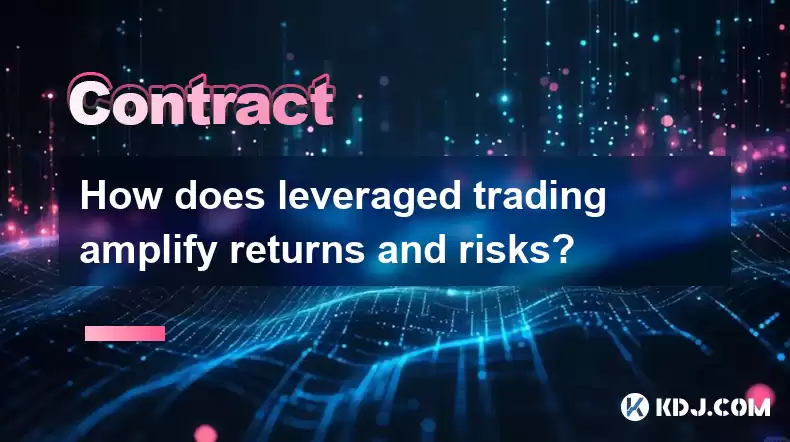-
 Bitcoin
Bitcoin $116700
0.24% -
 Ethereum
Ethereum $3973
4.34% -
 XRP
XRP $3.283
7.68% -
 Tether USDt
Tether USDt $1.000
0.01% -
 BNB
BNB $789.8
2.27% -
 Solana
Solana $176.2
3.31% -
 USDC
USDC $0.9999
0.00% -
 Dogecoin
Dogecoin $0.2238
5.14% -
 TRON
TRON $0.3389
-0.51% -
 Cardano
Cardano $0.7907
4.03% -
 Stellar
Stellar $0.4527
10.02% -
 Hyperliquid
Hyperliquid $41.07
4.27% -
 Sui
Sui $3.794
1.77% -
 Chainlink
Chainlink $19.49
10.40% -
 Bitcoin Cash
Bitcoin Cash $580.9
0.74% -
 Hedera
Hedera $0.2617
4.32% -
 Avalanche
Avalanche $23.41
3.67% -
 Ethena USDe
Ethena USDe $1.001
-0.03% -
 Litecoin
Litecoin $122.4
1.38% -
 Toncoin
Toncoin $3.364
1.49% -
 UNUS SED LEO
UNUS SED LEO $8.988
0.37% -
 Shiba Inu
Shiba Inu $0.00001295
2.82% -
 Uniswap
Uniswap $10.62
5.75% -
 Polkadot
Polkadot $3.922
4.46% -
 Dai
Dai $1.000
0.01% -
 Bitget Token
Bitget Token $4.494
2.15% -
 Monero
Monero $268.0
-1.30% -
 Cronos
Cronos $0.1523
3.68% -
 Pepe
Pepe $0.00001127
4.43% -
 Aave
Aave $285.4
4.85%
How does leveraged trading amplify returns and risks?
Leveraged trading in crypto can amplify returns and risks; using borrowed funds increases market exposure, but losses can be magnified, requiring careful risk management.
Apr 10, 2025 at 08:00 pm

Leveraged trading in the cryptocurrency market is a powerful tool that can significantly amplify both returns and risks. By using borrowed funds, traders can increase their exposure to the market, potentially leading to higher profits. However, this also means that losses can be magnified, making it a double-edged sword. Understanding how leverage works and its impact on trading outcomes is crucial for anyone looking to engage in this type of trading.
What is Leveraged Trading?
Leveraged trading involves borrowing capital to increase the size of a trading position beyond what would be possible with one's own funds alone. In the cryptocurrency market, this is often facilitated through margin trading on exchanges. For example, if a trader wants to buy Bitcoin and the exchange offers 10x leverage, they can control a position worth 10 times their initial investment. This means that with $1,000, they could potentially control a $10,000 position.
How Leverage Amplifies Returns
When the market moves in the trader's favor, leverage can significantly boost returns. For instance, if a trader uses 10x leverage to buy Bitcoin and the price increases by 1%, the trader's profit would be 10% of their initial investment, rather than just 1%. This is because the entire $10,000 position benefits from the price movement, not just the $1,000 initial investment.
To illustrate, let's consider a scenario where a trader uses 5x leverage to buy Ethereum. If the trader invests $2,000 and the price of Ethereum rises by 2%, the trader's position would be worth $2,000 5 1.02 = $10,200. After repaying the borrowed $8,000, the trader would be left with a profit of $200, which is a 10% return on their initial $2,000 investment.
How Leverage Amplifies Risks
On the flip side, leverage can also amplify losses. If the market moves against the trader, the losses are magnified by the same factor as the leverage. Using the previous example, if the price of Ethereum falls by 2% instead of rising, the trader's position would be worth $2,000 5 0.98 = $9,800. After repaying the borrowed $8,000, the trader would be left with only $1,800, resulting in a $200 loss, which is a 10% loss on their initial $2,000 investment.
Moreover, if the market moves significantly against the trader, they could face a margin call, where the exchange requires additional funds to maintain the position. If the trader cannot meet the margin call, the position may be liquidated, resulting in a total loss of the initial investment.
Practical Example of Leveraged Trading
To better understand how leveraged trading works in practice, let's walk through a step-by-step example of opening a leveraged position on a cryptocurrency exchange.
- Choose a reputable exchange that offers margin trading, such as Binance or Kraken.
- Fund your account with the necessary amount of cryptocurrency or fiat currency.
- Navigate to the margin trading section of the exchange.
- Select the cryptocurrency pair you want to trade, such as BTC/USDT.
- Choose the leverage level, for example, 10x.
- Enter the amount you want to invest, say $1,000.
- Review the order details, including the total position size ($10,000 in this case) and the potential profit or loss.
- Confirm the order to open the leveraged position.
- Monitor the position closely, as the market can be volatile and may require quick action to manage risk.
- Close the position when you decide to realize your profit or cut your losses.
Managing Risks in Leveraged Trading
Given the high risks associated with leveraged trading, it's essential to have a solid risk management strategy in place. Here are some key practices to consider:
- Set stop-loss orders to automatically close your position if the market moves against you beyond a certain point.
- Use lower leverage to reduce the potential for large losses. While higher leverage can lead to higher returns, it also increases the risk.
- Diversify your portfolio to spread the risk across different assets.
- Keep a close eye on market conditions and be prepared to adjust your positions accordingly.
- Only invest what you can afford to lose, as the potential for total loss is always present in leveraged trading.
Psychological Aspects of Leveraged Trading
The psychological impact of leveraged trading cannot be overstated. The potential for high returns can lead to overconfidence and greed, causing traders to take on more risk than they should. Conversely, the fear of significant losses can lead to panic selling and other irrational decisions. It's crucial for traders to maintain a disciplined approach and not let emotions drive their trading decisions.
Regulatory Considerations
In some jurisdictions, leveraged trading is subject to strict regulations to protect investors from the high risks involved. Traders should be aware of the legal framework in their country and ensure they comply with all relevant regulations. This may include limits on the amount of leverage offered, requirements for risk disclosure, and other protective measures.
Frequently Asked Questions
Q: Can I use leverage to short sell cryptocurrencies?
A: Yes, many exchanges allow traders to use leverage to short sell cryptocurrencies. This involves borrowing the cryptocurrency and selling it with the expectation that the price will fall, allowing you to buy it back at a lower price and return it to the lender, pocketing the difference as profit.
Q: What is the difference between isolated and cross margin trading?
A: In isolated margin trading, the margin for each position is isolated, meaning that losses on one position cannot affect other positions. In cross margin trading, the entire account balance is used as margin, allowing for more flexibility but also increasing the risk of a single position affecting the entire account.
Q: How do I calculate the liquidation price in leveraged trading?
A: The liquidation price is the price at which your position will be automatically closed to prevent further losses. It can be calculated using the formula: Liquidation Price = (Entry Price (1 - (1/Leverage))) / (1 + (Maintenance Margin Rate Leverage)). This formula may vary slightly depending on the exchange and the specific terms of the margin trading agreement.
Q: Are there any fees associated with leveraged trading?
A: Yes, most exchanges charge fees for leveraged trading, including interest on the borrowed funds, trading fees, and potentially other charges such as funding fees for perpetual futures contracts. It's important to understand all the fees involved before engaging in leveraged trading.
Disclaimer:info@kdj.com
The information provided is not trading advice. kdj.com does not assume any responsibility for any investments made based on the information provided in this article. Cryptocurrencies are highly volatile and it is highly recommended that you invest with caution after thorough research!
If you believe that the content used on this website infringes your copyright, please contact us immediately (info@kdj.com) and we will delete it promptly.
- Roman Storm, Funding Effort, and the Looming Defense Retrial: A New York Minute on the Tornado Cash Case
- 2025-08-09 02:50:14
- Crypto's Wild Ride: XRP, Dogecoin, and the Altcoin Surge You Can't Ignore
- 2025-08-09 02:50:14
- Elon Musk, Bitcoin, and the Enduring Power of Approval: A Crypto Love Story?
- 2025-08-09 03:50:15
- Ruvi AI: The Next Big Thing After Ripple on CoinMarketCap?
- 2025-08-09 03:50:15
- Floki Price Surges: Elliott Wave and Fibonacci Setups Point to Potential Gains!
- 2025-08-09 02:30:16
- Pepe Price, RTX (Remittix?) & the $10K ETH Dream: NYC Crypto Chatter
- 2025-08-09 02:30:16
Related knowledge

What is the difference between realized and unrealized PNL on KuCoin?
Aug 09,2025 at 01:49am
Understanding Realized and Unrealized PNL on KuCoinWhen trading on KuCoin, especially in futures and perpetual contracts, understanding the distinctio...

How does KuCoin Futures compare against Binance Futures in terms of features?
Aug 09,2025 at 03:22am
Trading Interface and User ExperienceThe trading interface is a critical component when comparing KuCoin Futures and Binance Futures, as it directly i...

What is the distinction between mark price and last price on KuCoin?
Aug 08,2025 at 01:58pm
Understanding the Basics of Price in Cryptocurrency TradingIn cryptocurrency exchanges like KuCoin, two key price indicators frequently appear on trad...

What are the specific maker and taker fees on KuCoin Futures?
Aug 08,2025 at 08:28am
Understanding Maker and Taker Fees on KuCoin FuturesWhen trading on KuCoin Futures, users encounter two primary types of fees: maker fees and taker fe...

Can you explain the difference between cross margin and isolated margin on KuCoin?
Aug 09,2025 at 02:57am
Understanding Margin Trading on KuCoinMargin trading on KuCoin allows traders to borrow funds to increase their trading position beyond their actual c...

How can I open a long position on KuCoin Futures?
Aug 09,2025 at 02:07am
Understanding KuCoin Futures and Long PositionsOpening a long position on KuCoin Futures means you are speculating that the price of a cryptocurrency ...

What is the difference between realized and unrealized PNL on KuCoin?
Aug 09,2025 at 01:49am
Understanding Realized and Unrealized PNL on KuCoinWhen trading on KuCoin, especially in futures and perpetual contracts, understanding the distinctio...

How does KuCoin Futures compare against Binance Futures in terms of features?
Aug 09,2025 at 03:22am
Trading Interface and User ExperienceThe trading interface is a critical component when comparing KuCoin Futures and Binance Futures, as it directly i...

What is the distinction between mark price and last price on KuCoin?
Aug 08,2025 at 01:58pm
Understanding the Basics of Price in Cryptocurrency TradingIn cryptocurrency exchanges like KuCoin, two key price indicators frequently appear on trad...

What are the specific maker and taker fees on KuCoin Futures?
Aug 08,2025 at 08:28am
Understanding Maker and Taker Fees on KuCoin FuturesWhen trading on KuCoin Futures, users encounter two primary types of fees: maker fees and taker fe...

Can you explain the difference between cross margin and isolated margin on KuCoin?
Aug 09,2025 at 02:57am
Understanding Margin Trading on KuCoinMargin trading on KuCoin allows traders to borrow funds to increase their trading position beyond their actual c...

How can I open a long position on KuCoin Futures?
Aug 09,2025 at 02:07am
Understanding KuCoin Futures and Long PositionsOpening a long position on KuCoin Futures means you are speculating that the price of a cryptocurrency ...
See all articles

























































































